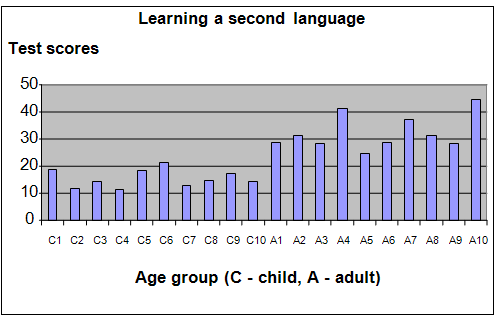| Complexity level: | 8 |
| Project cost ($): | 50 |
| Time required: | 7 days to prepare, 1 hour for the science project experiment |
| Material availability: | Easily found |
| Safety concerns: | None |
Hypothesis
Adults are able to acquire a second language more quickly than children.
Overview
Language acquisition
Second language acquisition is the process of learning a new language other than the native language of the person. For example, anyone who is not a native English speaker but who has learned the English language has acquired a second language.
It is interesting to observe the abilities of infants and young children to grasp and learn a new language with very little effort. There are theories that children are born with a natural ability to pick up new languages quickly while others argue that it is acquired through learning.
For an adult learning a second language, the biggest obstacle is to overcome self doubt in their own minds. Many studies have shown that adults are able to learn a new language more efficiently than children. In fact learning a new language will help to keep the mind of the adult active and healthy. Everyone can benefit from learning a new language, irrespective of age.
Scientific Terms
Materials
The materials required for the science fair project experiment:
- 10 children aged between 10 and 15 years old
- 10 adults aged between 25 and 40 years old
- 1 CD recording of lesson in the foreign language (that the above 20 participants have not yet learned).
- 1 CD player
- A test paper with 50 multiple-choice questions regarding the meaning of words taught in the CD
- A quiet classroom
- A clock
- An assistant
Procedure
1. For this science fair project, the independent variable is the two age-groups – 10 to 15 years and 25 to 40 years old. The dependent variable is the speed at which the participants are able to learn the second language. This is determined from the results of the test that they sit for. The constants (control variables) are the length of time they are allowed to listen to the CD, the number of test questions given and the time they are given to answer the questions.
2. The 20 participants are assembled in the classroom for 2 hours everyday to listen to the language CD. They are made to listen to the CD repeatedly for the next 7 days.
3. On the seventh day, they are made to sit for a test. The test will consist of 50 objective questions. The participants have to answer all questions in 1 hour. The questions are simple and ask for the meaning of words in English or the second language. The participants have to select the correct answers on paper.
4. After the hour is up, all question papers are collected and their scores tallied. The total number of correct answers for each participant is recorded in the table given below.

Results
The results showed that the adults scored higher in the test and were able to learn the second language more efficiently compared to the children.
|
Children |
Total correct answers from children |
|||||||||
|
C1 |
C2 |
C3 |
C4 |
C5 |
C6 |
C7 |
C8 |
C9 |
C10 |
|
|
Result |
19 |
12 |
14 |
11 |
18 |
21 |
13 |
15 |
17 |
14 |
|
Adults |
Total correct answers from adults |
|||||||||
|
A1 |
A2 |
A3 |
A4 |
A5 |
A6 |
A7 |
A8 |
A9 |
A10 |
|
|
Result |
29 |
31 |
28 |
41 |
25 |
29 |
37 |
31 |
28 |
45 |
The chart below represents the results of our science project experiment.

Conclusion
Our hypothesis has been proven to be true. Adults are able to acquire a second language more quickly than children.
Learning a second language in a class room and actually acquiring the language in a foreign land can be two very different experiences. Classroom environments involves memorizing words and learning grammar with little opportunity to practice the language. When you live in a foreign country, you will constantly hear the words being used and subconsciously learn the new words with correct pronunciation sentence construction and grammar.
Also consider
To improve the reliability and accuracy of our results, a larger sample of participants should be used.
This science fair project may be repeated, this time, by making the adults and children stay for a period of time in a foreign country or with a family that speaks the foreign language in order to compare their speed of learning
Modify the science project experiment, by having the children and adults attend language classes.
References
Second language acquisition - http://en.wikipedia.org/wiki/Second_language_acquisition
Language acquisition - http://en.wikipedia.org/wiki/Language_acquisition
Age and language learning - http://www.language-learning-advisor.com/age-and-language-learning.html

